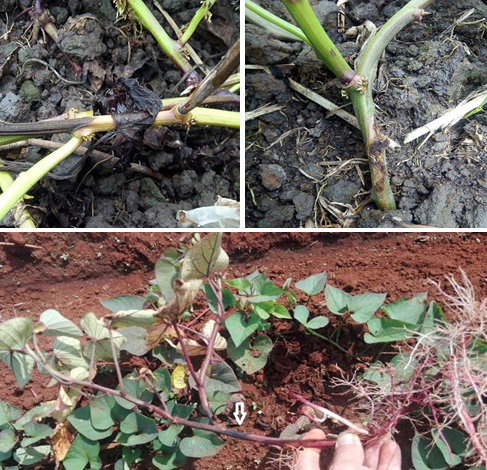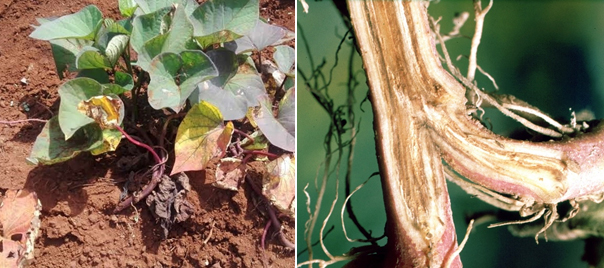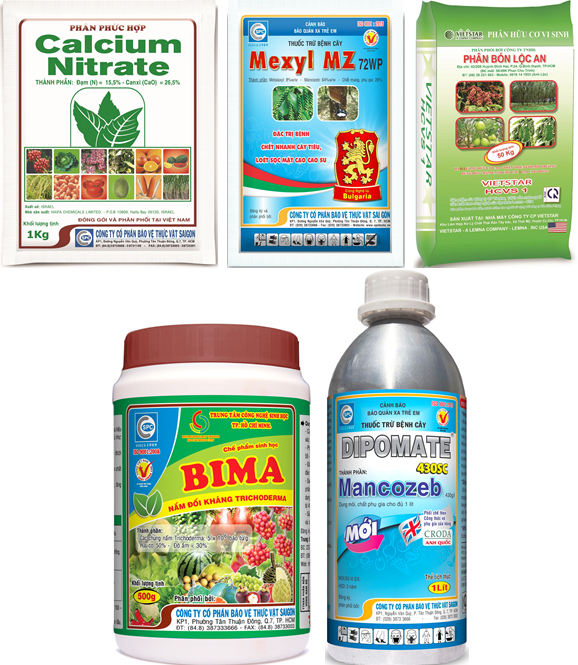|
Death disease on sweet potato vines
17/12/2021
BSc. Kim Xuan Loc Sweet potato vines have long helped farmers out of poverty on their land, but in recent years, a disease has begun to appear that causes mass death of sweet potato vines, leading to many sweet potato farming households with heavy losses. There have been many sweet potato fields that almost lost everything because of this disease. It is the death disease of vine (death with purple vine) on sweet potato plants, also known as yellow wilt disease, which is making sweet potato growers feel anxious every time they enter a new crop. Symptoms of the disease: The death disease on sweet potato vines is caused by the Fusarium sp fungus. The fungus invades and causes damage to the root of the sweet potato vine, 2-3 cm above the ground. They cause the vine to have dark brown wounds running along the vine.
These wounds block the vessels, making it difficult to transport water and nutrients, causing poor vine growth. At first, the leaf margins on older leaves are blood-colored, purple buds appear as Phosphorus deficiency phenomenon, cross-section of the stalk shows that the internal vessels is dark brown. Then the old leaves begin to turn yellow and wilt. Severe disease causes the vine being dry death. Symptoms are most obvious when the weather is rainy and sunny suddenly, the temperature is about 300C. The time from the time the vine showed symptoms of the disease to the wilt death of the tree lasted for months. Preventive measures: - Crop rotation of other crops. - Use cuttings from disease-free potato fields. - Clean up crop residues after harvest. - Uproot and destroy severely diseased plants. - Balanced fertilization Nitrogen - Phosphorus - Potassium. Add trace elements to sweet potatoes. - Before making the soil, add lime to disinfect, prevent fungal diseases and raise soil pH to help plants grow and develop well. - Before doing bed, apply rotten manure or microbial organic fertilizer (eg HCVS1 VIETSTAR) to stabilize the soil structure, increase humus, loose soil and destroy harmful pathogens in the soil. - Should add CALCIUM NITRATE 02 times/crop to increase the immunity of the roots and resistance to the potato vines. - Death disease of sweet potato is vine is difficult to treat, so it is necessary to pay attention to monitor the potato fields and proactively spray early disease prevention with BIMA products or copper-based products. Recently, the team of crop doctors of Saigon Plant Protection Joint Stock Company cooperated with farmer household Ho Thanh Dung, Thanh Trung commune, Binh Tan district, Vinh Long province to implement a model of spraying to prevent death disease of sweet potato is vine. With the treatment process of pesticides as follows, the disease prevention effect is quite successful: + Pre-preventive spraying: After 15 days of planting, treat with Dipomate 430SC or Mexyl MZ 72WP on the bed, with a dose (0.5 liters of Dipomate 430SC / 200 liters of water or 0.5 kg of Mexyl MZ 72WP / 200). liters of water) to irrigate 1000 m2. Then, every 20 days, irrigate once again until 1 month before harvest. + When the disease appears scattered in the potato field: Conduct treatment immediately with either Dipomate 430S or Mexyl MZ 72WP, irrigate 03 times continuously, 07 days apart. Then maintain irrigating once every 20 days until 1 month before harvest.
|
To prevent, in addition to plowing and burying weed seeds, collecting weed stalks and stumps left after tilling the land to burn, not letting weeds produce seeds in production fields, etc., the use of chemical products is still a measure. optimal because of its ability to thoroughly kill weeds, reduce labor and take advantage of more time than manual weeding.
Miner has the scientific name Phyllocnistis citrella Staint., family Phyllocnistidae, order Lepidoptera. The miner occurs in many countries in the tropics and subtropics. The main host of the miner is the citrus family - Rutaceae. In addition, the miner also attacks mangosteen and some other plants.
Adult is a small planthopper, with a body 2-3 mm long, the whole body is ash gray, slightly greenish, the wings are opaque with many small brown spots.Eggs are oval, 0.3 mm long, have a pointed end and are attached directly to the leaf surface, leaf axils.
Green bugs specialize in the fruit of citrus groups (oranges, tangerines, lemons, grapefruits, kumquats...), some people call them orange bugs, or orange suckers. Their scientific name is Rhynchocoris poseidon or Rhynchocoris humeralis.
In Vietnam, yellow leaf curl disease is very common on papaya trees, especially the disease is often severe in areas of high and continuous planting, areas with hot and arid climates. The disease has significantly reduced the yield and quality of papaya. Gardens that are infected early when the plants are young may not yield. However, up to now, many gardeners still do not know the cause and how to fix it.
Spider mites are common pests on citrus trees, especially in hot and dry climates that are suitable for spiders to grow and cause severe damage.The group of harmful spiders is usually very small in size, unlike the natural enemy spiders.
This group includes species that are generally very small in size, causing damage by sucking plant sap (on leaves, fruits, branches, stems).
There are many species of mealybugs present on the group of Oranges,Tangerines,Grapefruits and Lemons (Citrus), which can be divided into 2 groups:
+ Group of sticky mealybugs with common varieties such as Lepidosaphes, Aonidiella, Coccus and Saissetia.
+ Group of flower mealybugs with common genera and species such as Pseudococcus, Planococcus and Icerya purchasi.
Dry branches and berries disease often appear to be common damage on coffee gardens during the rainy season. The disease causes death of branchs, dry fruit, severely affects the canopy structure and coffee yield if not paid attention to prevention.
Pink disease commonly causes diseases on rubber plantations in the rainy season, especially on garden from 4-8 years old. This year, rubber has to go through a period of severe drought, weakening the tree, so now in tnshe rainy season it is easy to get infected. Therefore, it is necessary to pay attention to good management to avoid affecting the garden.
In recent years, the area of citrus has been expanded because it is a fruit tree with high economic efficiency. However, in order to sell at a high price, not only in quality but consumers also require the external beauty of the fruit, so pest management on citrus is a matter of great concern to farmers. The hot season is a favorable condition for thrips to develop and cause damage, affecting the commercial value of fruit.
- Headquarters
- SAIGON PLANT PROTECTION JOINT STOCK COMPANY
- RQ 1, Nguyen Van Quy St., Tan Thuan Ward, HCM City
- Tax code: 0300632232
- Tel: (028) 38 733 295 - 38 732 077
- Fax: (028) 38 733 003 - 38 733 391
- Website: www.spchcmc.vn - Email: info@spchcmc.vn
- SAIGON PLANT PROTECTION COMPANY
- SAIGON PLANT PROTECTION JOINT STOCK ENTERPRISE
- Lot C1-C3 Hiep Phuoc Industrial Park, Hiep Phuoc Commune, HCM City
- Tel: (028) 3873 4089 - Fax: (028) 3873 4086
- Affiliated Unit
-
- Quick Links
- Home
- About us
- Career Opportunities














